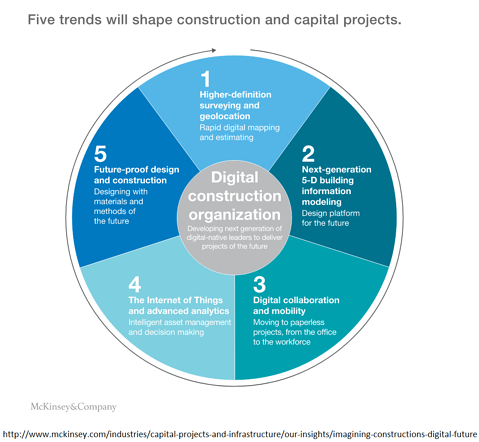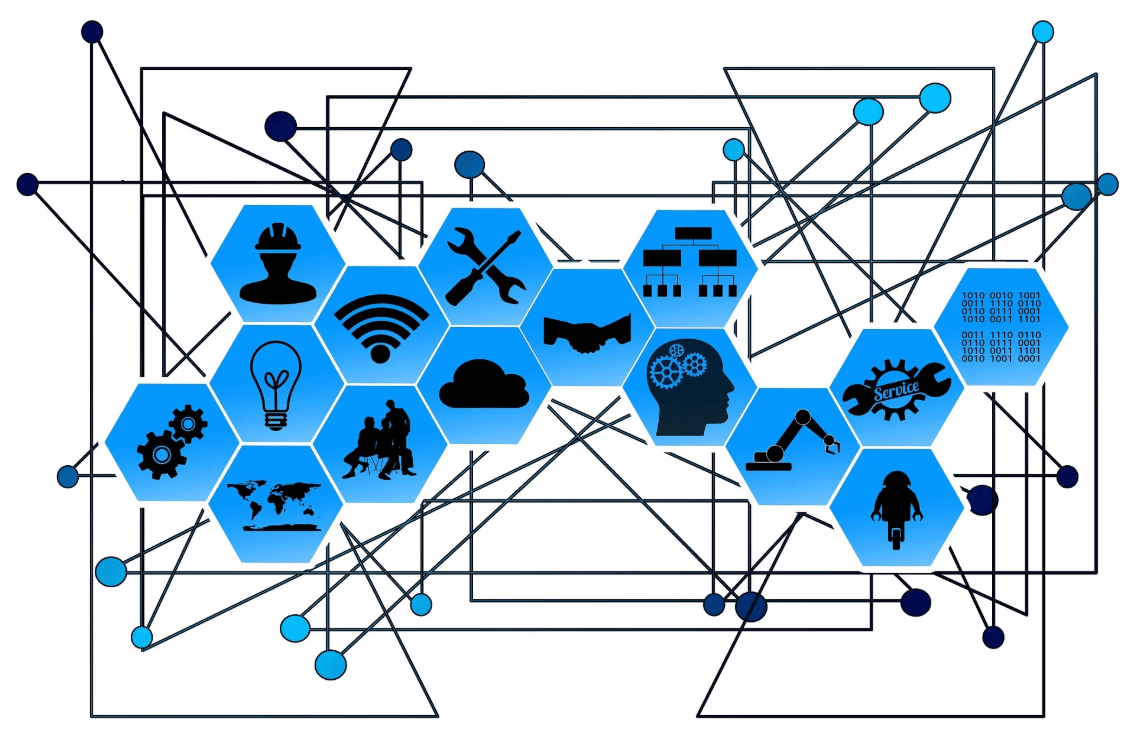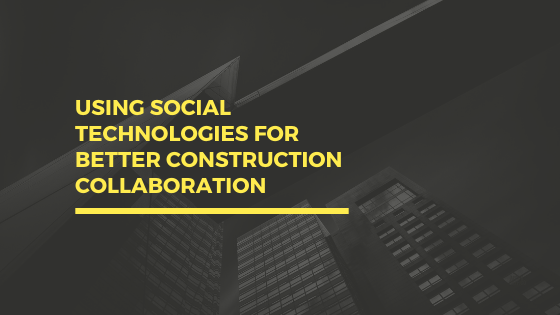HISTORY OF POOR PRODUCTIVITY
In a report entitled Imagining construction’s digital future, McKinsey & Company identified five trends that will shape construction and capital projects, with digital collaboration and mobility being one of such trends.
The report attributes the construction industry’s history of poor productivity to the reliance by many of its members on paper to manage the construction processes. The “lack of digitization” results in delays in sharing information, with project stakeholders often working from different versions of data. Messy paper trails may also cause disagreements between the parties on issues such as construction variations and extension of time claims.
RESISTANCE TO CHANGE
In a report entitled Imagining construction’s digital future, McKinsey & Company identified five trends that will shape construction and capital projects, with digital collaboration and mobility being one of such trends.

The report attributes the construction industry’s history of poor productivity to the reliance by many of its members on paper to manage the construction processes. The “lack of digitization” results in delays in sharing information, with project stakeholders often working from different versions of data. Messy paper trails may also cause disagreements between the parties on issues such as construction variations and extension of time claims.
RESISTANCE TO CHANGE
Parts of the industry (mainly large project developers and contractors) have already implemented digital-collaboration and mobility solutions, such as online, real-time sharing of information and collaboration. However, this trend is not as widespread among many of the smaller contractors. The most frequent excuses given by them are lack of time to try something new and the concern over how such change will disrupt their workflow and ultimately their businesses.
Of course, these are legitimate concerns. At the same time, the construction industry can no longer ignore the significant benefits of using modern technology to improve efficiency, to offer value to clients and, ultimately, to enhance a company’s competitive position.
CLOUD COMPUTING & SAAS
The advances in cloud computing has resulted in an abundance of available construction software solutions that uses the principle of Software-as-a-service (SaaS), offering software, storage and support in return for a regular subscription fee. This is an ideal solution for small and mid-tier contractors as it does not involve dedicating a large capital outlay to benefit from the latest technology. SaaS is also a scalable solution providing a system that can respond to the changes in your business volume; you can use as much or as little of it as your business needs.
As distinguished novelist Ursula LeGuin said: “Morning comes whether you set the alarm or not.”, technology is here to stay and its benefits are undeniable. It’s up to you whether you use it to your advantage or be content to watch your competitors reap its benefits and leave you behind.
HOW TO MINIMISE THE DISRUPTION TO YOUR BUSINESS
This begs the question: Is there a way to eliminate or minimise the disruption to your business when you start using modern technology or you move from one software system to another one more advanced/appropriate to your business?
The following are some ideas that may help to answer this question for many of the small and mid-tier contractors:
- Define your business needs
It can certainly be daunting to try to pick a construction management software that will meet your needs in terms of project management functionality. It is therefore important to start with defining your business needs before trying to find the most suitable solution:
- Do you need a bid management tool to help your estimating team create and distribute tender packages to sub-contractors easily and receive quotes in the correct break-up?
- Do you need a document management and distribution tool that helps your teams to add, group, view, share and revise all project documentation?
- Do you need a Plan Viewer to view and mark-up/add comments to construction plans on a computer or any smart mobile device?
- Do you need a construction site diary to help your project team stay up to date with all daily site activities using a computer or any smart mobile device?
- Do you need a defects/punchlist management tool to log and distribute defective work notices, including photos and marked-up plans, from the office or the site, on any smart mobile device?
- Do you need a safety inspection tool to create your own safety inspection templates, a running list of safety inspection items that require action and assign them to the responsible parties to be actioned?
- Define other management tools that you need to manage your projects, such as Meeting Minutes, RFI’s, Extension of Time claims, Variations/Change Orders, Purchase Orders, Backcharge Notices, Non-conformance Notices, and Project Progress Reports.

- Do your research
The next step is to do your research and find a software system that meets all, or at least most, of your critical business needs. Mobility is a powerful tool to facilitate collaboration between the office team and site teams, as well as with other project stakeholders. Ensure that the system you choose can be accessed and operated on any smart mobile device as this will significantly enhance the collaboration advantage.
Other issues to consider include:
- Is there an establishment/set up costs involved?
- Do you only pay for your internal users that you need or is there a minimum charge?
- Can you add external companies to your project to collaborate with you free of charge?
- Does the software provider allows you a free trial period?
- Is there a limit on the file or storage capacity that you are allowed?
- Is free training and support provided as part of the package?
- Do you have to commit to a long term contract or can you cancel by giving a short notice?
- Do you get automatic upgrades of the system free of charge or do you have to pay?
- Are there any other fees or charges beside the regular subscription fee?
- Is the system secure enough to entrust with your confidential business information? (For example, you should look for a provider that uses Advanced Encryption Standard (AES) 256 as a minimum. This is a secure symmetric-key encryption standard using 256-bit encryption keys.)
- Make use of free trial periods
All reputable construction software providers will be happy to offer you a free trial period so that your team can try the system’s features and capabilities to ensure that they meet your business needs. Make sure that you look particularly at the following aspects during the free trial period in order to minimise the potential disruption to your business:
- Easy on-boarding and setup: No lengthy or expensive set up procedure. You should be able to get your project team on and working in minutes.
- User friendly features: Simple interface including tips to make sure your team can quickly learn how to use the system’s functions with minimal disruption to projects.
- Automated functions: Functions such as documents and plans revisions should be automated to the fullest extent possible.
- Collaboration without barriers: External companies working on your project should be able to communicate and collaborate with you fully without the need to have an account with your software provider.
- Audit Trail: All communication must be captured in an audit trail to ensure that you have documentary evidence in case of disputes.
- Service: Do you receive a professional and personalised service from the software provider, where you can talk to an account manager if you need help? Or are you directed to a typical “Help” menu with questions and answers and ultimate can only send an email to some anonymous “Help Desk” and then wait and hope for a quick response?
- Customisation: Is the software provider prepared and able to undertake any necessary customisation to the software to ensure that it meets 100% of your business needs?
- Start with new projects
Now that you’ve found the system that’s ideal for your business, there is no sense in complicating matters by trying to move existing projects to the new system. If you are using another system it will mean having to finish your current work on the old system and use the new system for new projects. This is perhaps the least disruptive way to move from one system to another, and it also gives your team an opportunity to familiarise themselves with the new system.
CONCLUSION:
The use of modern information and telecommunication technology can offer many benefits to the construction industry. Small and mid-tier firms appear reluctant to adopt digital-collaboration and mobility solutions, such as online, real-time sharing of information and collaboration. The main reasons given for this reluctance are lack of time and the concerns over the possible disruption to the business by moving away from the old paper-based processes, or moving from one system to another one more suited to the contractor’s business needs.
However, the benefits of using the latest available technology cannot be denied, and contractors can minimise the possible disruption to their businesses by following some simple planning procedures in researching and selecting the right construction management system.






